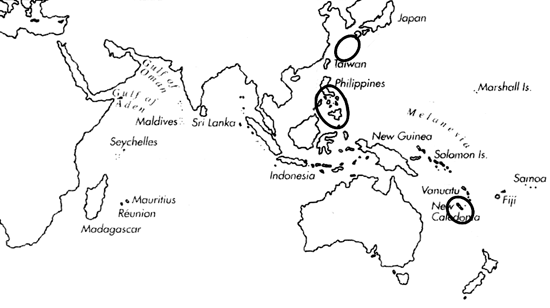Range: Ryukyu Is., Philippines, New Caledonia.
Description: Small and light. Last whorl usually conical, outline almost straight; left side slightly concave at base. Shoulder angulate to carinate. Spire usually of moderate height, slightly stepped; outline concave. Larval shell of 3.25-3.5 whorls, maximum diameter 0.8-1 mm. First 2-5 postnuclear whorls tuberculate, following whorls carinate. Teleoconch sutural ramps flat or slightly concave, with arcuate radial threads; spiral striation obsolete or absent. Last whorl glossy, with a few spiral ribs and ribbons at base and 1-2 fine spiral grooves below shoulder.
| Shell Morphometry | ||
|---|---|---|
| L | 15-24 mm | |
| RW | 0.03-0.06 g/mm | |
| RD | 0.61-0.68 | |
| PMD | 0.84-0.96 | |
| RSH | 0.17-0.24 | |
Ground colour violet-grey or beige. Last whorl variably overlaid with brown axial blotches and numerous variably broad spiral rows of alternating brown and light dots and dashes. A narrow light spiral band located below centre, often a similar but less prominent light band above centre. Larval whorls white to beige. Postnuclear sutural ramps with brown radial blotches and darker brown dots along the outer margin. Aperture violet.
Habitat and Habits: In 120-380 m.
Discussion: C. Aphrodite resembles C. memiae and C. dayriti. The latter species differs in its lower spire (RSH 0.07-0.17) and its spirally grooved sutural ramps; only its first 0.25-2 postnuclear whorls are weakly tuberculate or undulate. For comparison with C. memiae, see the Discussion of that species.

C. aphrodite range map
This section contains verbatim reproductions of the accounts of 316 species of Conus from the Indo-Pacific region, from Manual of the Living Conidae, by Röckel, Korn and Kohn (1995). They are reproduced with the kind permission of the present publisher, Conchbooks.
All plates and figures referred to in the text are also in Röckel, Korn & Kohn, 1995. Manual of the Living Conidae Vol. 1: Indo-Pacific Region.
The range maps have been modified so that each species account has it own map, rather than one map that showed the ranges of several species in the original work. This was necessary because each species account is on a separate page on the website and not confined to the order of accounts in the book.